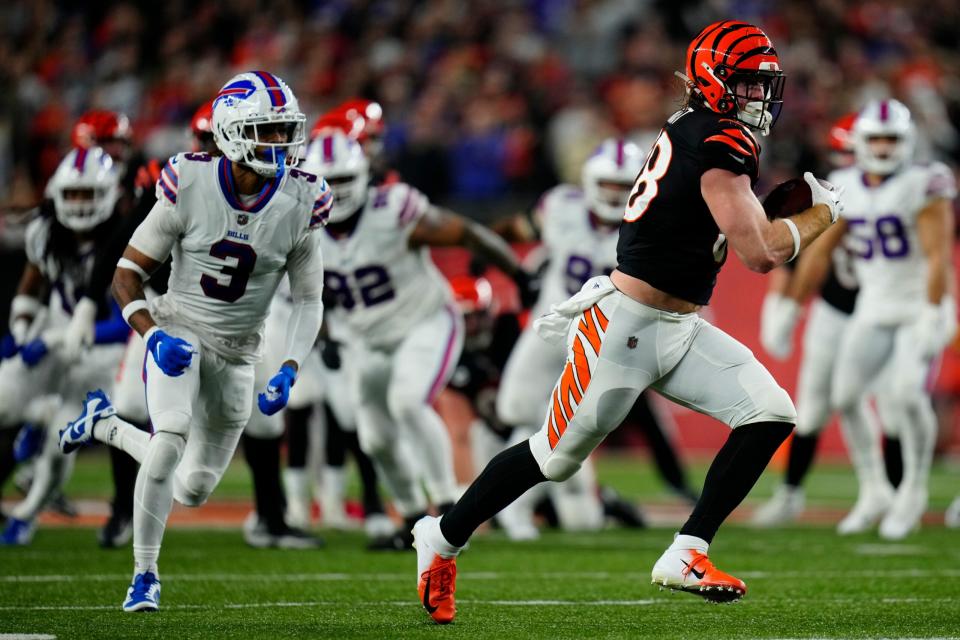What is commotio cordis? NOCSAE expert discusses heart condition

The collision and hospitalization of Buffalo Bills safety Damar Hamlin in January 2023 brought to the forefront a risk many average football fans were previously unaware of: commotio cordis. As player safety continues being discussed around the league, this condition will have a heightened focus.
While many are learning of the condition now, records have been found of similar incidents dating back to the 1700s. However, little was known about commotio cordis as recently as 30 years ago until the National Operating Committee on Standards for Athletic Equipment (NOCSAE) began to study this cardiac arrest event in 1995. With the help of this organization, which created a registry to track incidents and developed safety standards for baseball and lacrosse, there is more awareness.
What is commotio cordis and what should you do if you are a coach or spectator when it occurs? Mike Oliver, the NOCSAE executive director and legal counsel, participated in an interview with USA TODAY High School Sports to discuss NOCSAE’s work and how commotio cordis affects athletes.
What is commotio cordis?
Commotio cordis occurs when a hit to the chest disrupts the heart’s rhythm. A very rare condition that requires impact at a specific time of the heartbeat and at a near-perpendicular angle, it can lead to sudden cardiac death in athletes.
“It’s the consequence of getting hit over the heart in the right spot at the right point in the cardiac cycle,” Oliver said.
Commotio cordis does not stop the heart, but it changes the rhythm of the heartbeat in a way that makes chambers of the heart work individually and prevents the heart from moving blood, Oliver said.
What are the symptoms of commotio cordis?
Oliver pointed to Hamlin’s case as a textbook example of the symptoms. After getting hit in the chest, Hamlin did not immediately collapse — he got to his feet and took a couple of steps before falling back to the ground.
“If you’re on the field and see a player behave like that after getting hit in the chest, don’t take that lightly. Take that very seriously,” Oliver said. “If there’s an AED close by, and you get it on that kid within two to three minutes, you really improve the chance of that kid surviving.”
In which sports is commotio cordis most prevalent?
The event is more common in projectile sports such as baseball, softball and lacrosse. Because the balls used are consistent shapes and sizes within the sport, it’s easier to track than football, in which people may get hit by a ball, helmet, elbow, knee, or other areas.
“Of all the sports where you might see a commotio cordis event, football is one of the least likely sports where it could happen,” Oliver said.
The velocity of the impact also plays a role, but it’s not necessarily based on the hardest or fastest hits. Once the speed of a ball reaches about 40-50 miles per hour, Oliver said, the chance of getting commotio cordis actually goes down.
He said the reason is not clear, but there are a couple theories. One is that the energy of the impact peaks too early to affect the cardiac cycle. The other relates to how the body absorbs the impact of the hit.
“Once you get up above about 45-50 miles per hour, if you don’t have protection, an impact with a baseball will do some measurable damage to the tissue – it’s going to bruise it, it could even maybe break a rib or cause a lot of trauma to the tissue. In doing so, the body’s sort of acting like a protective pad,” Oliver said. “It’s absorbing a lot of that stuff, so not as much gets through to the heart.”
Is the number of incidents increasing?
Oliver attributes increased numbers not to an increase in incidents, but instead to wider recognition of the condition.
“There’s a little bit of a parallel, I think, with concussions,” he said. “It wasn’t that long ago where the definition of a concussion required that you be unconscious. If you weren’t knocked unconscious, it wasn’t a concussion.”
There is now broader awareness that concussions can occur even while the person remains conscious, meaning more concussions are reported. Likewise, people are more aware of commotio cordis and are better able to define it when they see it.
That theory is reflected in the increase of commotio cordis reports in the late 1990s and early 2000s. There were only five recorded instances from 1895-1970 in a 2006 Heart Rhythm Society report, but in the early 2000s, the number ballooned and peaked at 18 cases in one year.
Today, there are approximately 15-25 deaths from the condition each year, according to NOCSAE.
How do you protect players from severe impacts of commotio cordis?
Hamlin’s case was a good example of a life-saving treatment. The most important thing to do is to apply a defibrillator to the affected athlete as soon as possible. Oliver said that for every minute it takes to defibrillate the affected athlete, chances of success reduce by at least 10%.
NOCSAE released standards for baseball and lacrosse equipment manufacturers describing how chest protectors can best prevent the episode from occurring. The baseball standards, finalized in 2017, are now required for catchers by the NCAA and National Federation of State High School Associations (NFSH), and lacrosse standards are required for goalies by the NCAA, NFSH and USA Lacrosse.
What is NOCSAE working on?
In addition to its work with baseball and lacrosse, the non-profit is working with the NFL to create a standard for shoulder pads. The two-year project was originally centered around concussions, but the league has expanded its interest to see how the investigation of shoulder pads can minimize the risk of commotio cordis as well.
